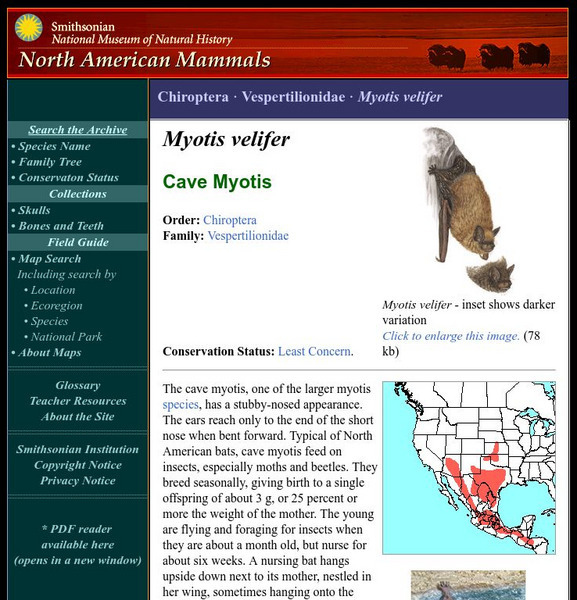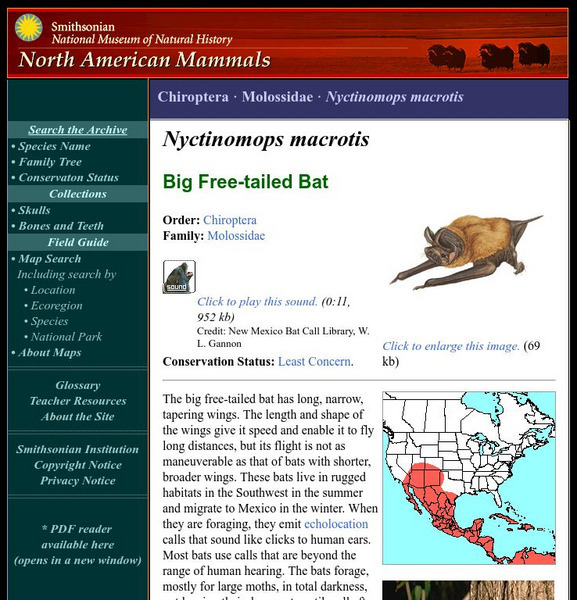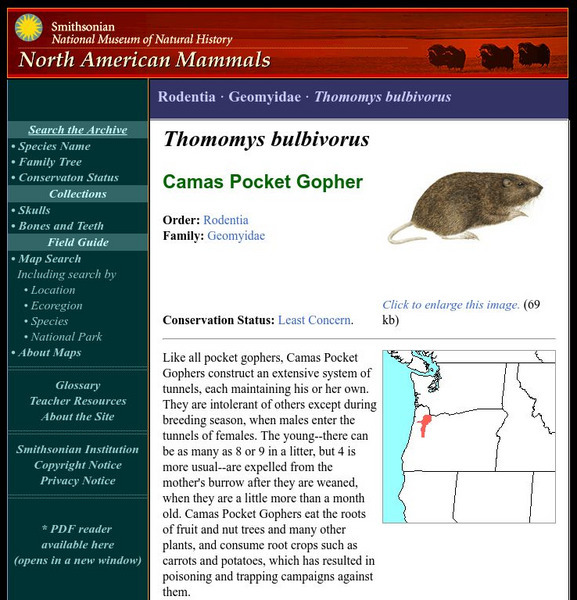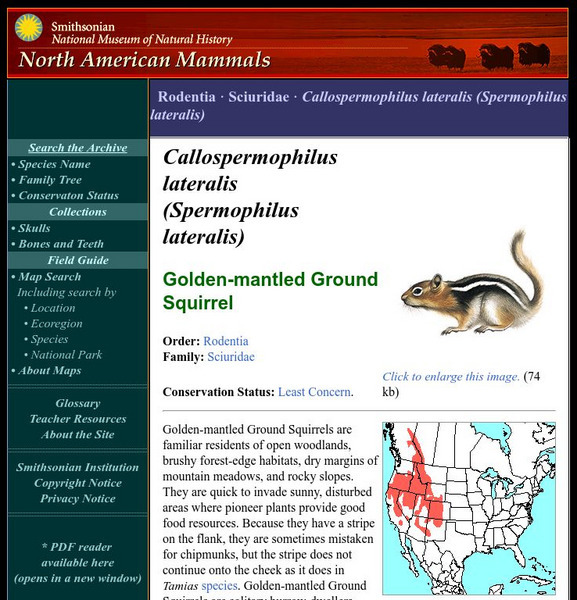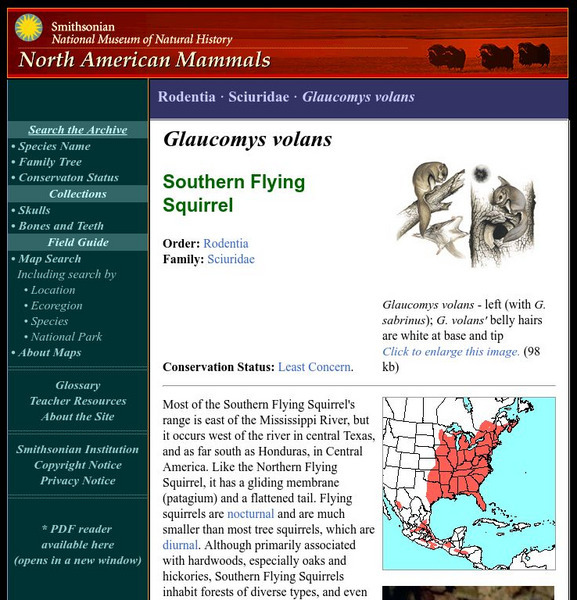Smithsonian Institution
National Museum of Natural History: American Mammals: Big Eared Kangaroo Rat
The Big-eared Kangaroo Rat has the longest ears of any kangaroo rat, and weighing in at about 85 g, is one of the largest Dipodomys species in California. It is dark cinnamon in color, with white underparts and brown ears. Learn more...
Smithsonian Institution
National Museum of Natural History: American Mammals: California Kangaroo Rat
California Kangaroo Rats require open areas away from the humidity of the coast in northern California and southern Oregon. They seem to need well-drained soil, and after a rain can be seen pushing mud out of their burrows. Learn more...
Smithsonian Institution
National Museum of Natural History: American Mammals: Baird's Beaked Whale
Baird's beaked whale is the longest species of the Ziphiidae, which is a family of medium-sized whales. The name "beaked whale" comes from the way the long snout, or rostrum, tapers to a tip. Learn more about the Berardius bairdii, more...
Smithsonian Institution
National Museum of Natural History: American Mammals: Barren Ground Shrew
An inhabitant of the far north, the Barren Ground Shrew lives on the tundra from Point Barrow, Alaska, to the western shore of Hudson Bay, Canada. The fur on its back forms a well-defined brown stripe, and its sides and undersides are...
Smithsonian Institution
National Museum of Natural History: American Mammals: Cockrum's Gray Shrew
With developments in molecular biology, biologists have powerful new tools to determine the relatedness of specimens found at different locations. Studies of chromosomes and gene sequences have helped identify Cockrum's Gray Shrew and...
Smithsonian Institution
National Museum of Natural History: American Mammals: Bowhead Whale
Bowheads live in icy Arctic seas. A smooth back with no dorsal fin, a blowhole placed in a high crown at the top of the head, and a thick layer of blubber for insulation equip them for this environment. Learn more about the Balaena...
Smithsonian Institution
National Museum of Natural History: American Mammals: Cave Myotis
The cave myotis, one of the larger myotis species, has a stubby-nosed appearance. The ears reach only to the end of the short nose when bent forward. Learn more about the Myotis velifer, more commonly known as a Cave Myotis, in this...
Smithsonian Institution
National Museum of Natural History: American Mammals: Big Free Tailed Bat
The big free-tailed bat has long, narrow, tapering wings. The length and shape of the wings give it speed and enable it to fly long distances, but its flight is not as maneuverable as that of bats with shorter, broader wings. Learn more...
Smithsonian Institution
National Museum of Natural History: American Mammals: Brazilian Free Tailed Bat
Millions of Brazilian free-tailed bats spend their summers in the southwestern United States. Gigantic colonies summer in Bracken Cave, Texas; Carlsbad Caverns, New Mexico; and even within the city of Austin, Texas, under the Congress...
Smithsonian Institution
National Museum of Natural History: American Mammals: Camas Pocket Gopher
Like all pocket gophers, Camas Pocket Gophers construct an extensive system of tunnels, each maintaining his or her own. They are intolerant of others except during breeding season, when males enter the tunnels of females. Learn more...
Smithsonian Institution
National Museum of Natural History: American Mammals: Pacific White Sided Dolphin
Before the United Nations established a moratorium on the use of high seas drift nets in 1993, Pacific white-sided dolphins were frequently caught in the nets of Japanese and Korean squid fisheries. Today the species is better protected,...
Smithsonian Institution
National Museum of Natural History: American Mammals: Western Small Footed Myotis
The western small-footed myotis occurs in limited areas of southwestern Canada, throughout much of the western United States, and into Mexico. It is better adapted to moist areas than to dry ones. Learn more about the Myotis ciliolabrum,...
Smithsonian Institution
National Museum of Natural History: American Mammals: Golden Mantled Ground Squirrel
Golden-mantled Ground Squirrels are familiar residents of open woodlands, brushy forest-edge habitats, dry margins of mountain meadows, and rocky slopes. They are quick to invade sunny, disturbed areas where pioneer plants provide good...
Smithsonian Institution
National Museum of Natural History: American Mammals: Pantropical Spotted Dolphin
As its common name suggests, the pantropical spotted dolphin is a spotted dolphin that occurs in tropical waters around the world. It is one of the species that fisherman tend to follow as a means of finding yellowfin tuna, which swim...
Smithsonian Institution
National Museum of Natural History: American Mammals: Chisel Toothed Kangaroo Rat
The Chisel-toothed Kangaroo Rat has chisel-shaped lower incisors, with which it strips the epidermis from the leaves of desert shadscale or saltbush, thereby reaching the palatable and water-rich interior of the leaf. This Kangaroo Rat...
Smithsonian Institution
National Museum of Natural History: American Mammals: White Footed Vole
White-footed Voles inhabit a relatively small area of the Pacific coast of North America, from Humboldt Bay, California, north to the Columbia River. They have small eyes, and their claws are suitable for burrowing, so they probably have...
Smithsonian Institution
National Museum of Natural History: American Mammals: Red Tree Vole
The home range of a Red Tree Vole may consist of just one tree, usually a large old Douglas-fir, where the vole builds its nest, eats the needles, and gets water by licking dew drops from the needles. Nests have been found more than 50 m...
Smithsonian Institution
National Museum of Natural History: American Mammals: Texas Pocket Gopher
Only soils with low percentages of silt, clay, and gravel will do for the Texas Pocket Gopher, so many of its populations are isolated from one another. The species occurs in southern Texas and extreme northeastern Mexico, burrowing in...
Smithsonian Institution
National Museum of Natural History: American Mammals: Southern Flying Squirrel
Most of the Southern Flying Squirrel's range is east of the Mississippi River, but it occurs west of the river in central Texas, and as far south as Honduras, in Central America. Like the Northern Flying Squirrel, it has a gliding...
Smithsonian Institution
National Museum of Natural History: American Mammals: Wolverine
Wolverines are widely distributed in the northern reaches of both hemispheres. In North America, they occupy remote habitats from the high mountainous interior of the Rockies to Arctic coastal tundra. Learn more about the Gulo gulo, more...
Smithsonian Institution
National Museum of Natural History: American Mammals: Snowshoe Hare
The Snowshoe Hare is broadly distributed in the north from coast to coast and occurs in a variety of habitat types, including swamps, hardwood forests, and mixed and evergreen forests. Nocturnal like most members of the family, this hare...
Smithsonian Institution
National Museum of Natural History: American Mammals: White Sided Jackrabbit
The White-sided Jackrabbit strongly prefers level ground to hills, and does not require shrubs for cover, but uses clumps or dense stands of grass instead. Grass also makes up more than 99 percent of its diet. Learn more about the Lepus...
Smithsonian Institution
National Museum of Natural History: American Mammals: Northern River Otter
River Otters can be thought of - and in a very real sense are - semi-aquatic weasels. Like fishers, martens, and mink, they have long, slender bodies, short limbs, and a short face, plus a set of adaptations for their aquatic lifestyle:...
Smithsonian Institution
National Museum of Natural History: American Mammals: Yellow Bellied Marmot
The Yellow-bellied Marmot has the thickset build characteristic of the genus. Its fur is relatively long and coarse, with buffy to yellowish hair running from the sides of the neck down along the chest. Learn more about the Marmota...






